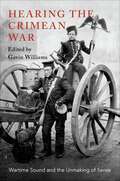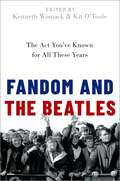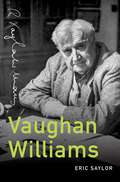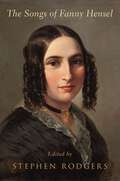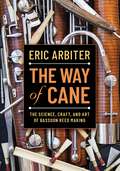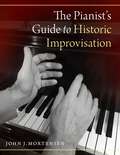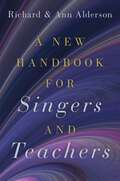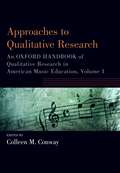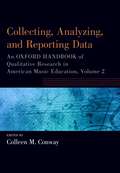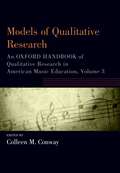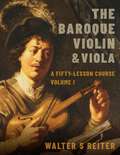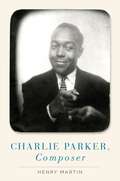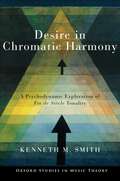- Table View
- List View
HEARING THE CRIMEAN WAR C: Wartime Sound and the Unmaking of Sense
by Gavin WilliamsWhat does sound, whether preserved or lost, tell us about nineteenth-century wartime? Hearing the Crimean War: Wartime Sound and the Unmaking of Sense pursues this question through the many territories affected by the Crimean War, including Britain, France, Turkey, Russia, Italy, Poland, Latvia, Dagestan, Chechnya, and Crimea. Examining the experience of listeners and the politics of archiving sound, it reveals the close interplay between nineteenth-century geographies of empire and the media through which wartime sounds became audible--or failed to do so. The volume explores the dynamics of sound both in violent encounters on the battlefield and in the experience of listeners far-removed from theaters of war, each essay interrogating the Crimean War's sonic archive in order to address a broad set of issues in musicology, ethnomusicology, literary studies, the history of the senses and sound studies.
Fandom and The Beatles: The Act You've Known for All These Years
More than 50 years after their breakup, the Beatles are still attracting fans from various generations, all while retaining their original fan base from the 1960s. Why have those first-generation fans continued following the Beatles and are now introducing their grandchildren to the group? Why are current teens affected by the band's music? And perhaps most importantly, how and why do the Beatles continue to resonate with successive generations? Unlike other bands of their era, the Beatles seem permanently frozen in time, having never descended into "nostalgia act" territory. Instead, even after the announcement of the band's breakup in 1970, the group has maintained its cultural and musical relevance. Their timeless quality appeals to younger generations while maintaining the loyalty of older fans. While the Beatles indeed represent a specific time period, their music and words address issues as meaningful today as they were during the Summer of Love: politics, war, sex, drugs, art, and creative liberation. As the first anthology to assess the nature of fan response and the band's enduring appeal, Fandom and the Beatles: The Act You've Known for All These Years defines and explores these unique qualities and the key ways in which this particular pop fusion has inspired such loyalty and multigenerational popularity.
Fandom and The Beatles: The Act You've Known for All These Years
by Kenneth Womack, Kit O’tooleMore than 50 years after their breakup, the Beatles are still attracting fans from various generations, all while retaining their original fan base from the 1960s. Why have those first-generation fans continued following the Beatles and are now introducing their grandchildren to the group? Why are current teens affected by the band's music? And perhaps most importantly, how and why do the Beatles continue to resonate with successive generations? Unlike other bands of their era, the Beatles seem permanently frozen in time, having never descended into "nostalgia act" territory. Instead, even after the announcement of the band's breakup in 1970, the group has maintained its cultural and musical relevance. Their timeless quality appeals to younger generations while maintaining the loyalty of older fans. While the Beatles indeed represent a specific time period, their music and words address issues as meaningful today as they were during the Summer of Love: politics, war, sex, drugs, art, and creative liberation. As the first anthology to assess the nature of fan response and the band's enduring appeal, Fandom and the Beatles: The Act You've Known for All These Years defines and explores these unique qualities and the key ways in which this particular pop fusion has inspired such loyalty and multigenerational popularity.
Vaughan Williams (Master Musicians Series)
by Eric SaylorA new biography of which paints the most well-rounded and factually accurate portrait of the composer to date Ralph Vaughan Williams ranks among the most versatile, influential, and enduringly popular British musicians of his era. Throughout his wide-ranging career-as composer, conductor, editor, scholar, folksong collector, teacher, author, administrator, and philanthropist-Vaughan Williams worked tirelessly to improve the standards and quality of British musical life. His dedicated work ethic and fastidious attention to musical detail helped him forge a compelling and original expressive idiom grounded in a profound understanding of musical history and tradition, popularized in concert staples like the Tallis Fantasia, The Lark Ascending, A London Symphony, the Songs of Travel, and the Serenade to Music. Drawing upon both recent scholarship and newly accessible scores and correspondence, author Eric Saylor interweaves in Vaughan Williams an exploration of the composer's life - including new insights about his early career, military service in the Great War, and relationships with the women he loved and married - with chapters surveying his enormous body of music, spanning hymn tunes to operas, keyboard etudes to solo concerti, wind band music for amateurs to perhaps the finest symphonic cycle of the twentieth century. The resulting portrait reveals Vaughan Williams's complex artistry and dynamic personality, a portrayal often at odds with the avuncular persona of "Uncle Ralph" familiar to the public. This contemporary reassessment of the composer's life and works provides a concise and engaging overview of both, positioning Vaughan Williams as an artist of rare skill, sensitivity, and human insight.
Vaughan Williams (Master Musicians Series)
by Eric SaylorA new biography of which paints the most well-rounded and factually accurate portrait of the composer to date Ralph Vaughan Williams ranks among the most versatile, influential, and enduringly popular British musicians of his era. Throughout his wide-ranging career-as composer, conductor, editor, scholar, folksong collector, teacher, author, administrator, and philanthropist-Vaughan Williams worked tirelessly to improve the standards and quality of British musical life. His dedicated work ethic and fastidious attention to musical detail helped him forge a compelling and original expressive idiom grounded in a profound understanding of musical history and tradition, popularized in concert staples like the Tallis Fantasia, The Lark Ascending, A London Symphony, the Songs of Travel, and the Serenade to Music. Drawing upon both recent scholarship and newly accessible scores and correspondence, author Eric Saylor interweaves in Vaughan Williams an exploration of the composer's life - including new insights about his early career, military service in the Great War, and relationships with the women he loved and married - with chapters surveying his enormous body of music, spanning hymn tunes to operas, keyboard etudes to solo concerti, wind band music for amateurs to perhaps the finest symphonic cycle of the twentieth century. The resulting portrait reveals Vaughan Williams's complex artistry and dynamic personality, a portrayal often at odds with the avuncular persona of "Uncle Ralph" familiar to the public. This contemporary reassessment of the composer's life and works provides a concise and engaging overview of both, positioning Vaughan Williams as an artist of rare skill, sensitivity, and human insight.
The Songs of Fanny Hensel
Fanny Hensel created some of the most imaginative and original music of her era, making her arguably the most gifted female composer of the nineteenth century. While Hensel has finally stepped out of the shadow of her famous brother, Felix Mendelssohn, as scholars have begun to study her life and writings, her music has remained surprisingly underexamined. This collection places Hensel's music at the center, focusing on the genre that not only made up more than half of her creative output but also, as Hensel herself put it, "suits her best": song. In eleven new essays, leading scholars in the fields of music theory and musicology consider Hensel's songs from a wide range of angles, covering topics such as Hensel's fascination with particular poets and poetic themes; her innovative harmonic, melodic, rhythmic, and textual strategies; and her connection to larger literary and musical trends. The chapters also provide insight into Hensel's efforts to break free from the constraints placed on her as a woman and her place in the larger history of the nineteenth-century Lied. Drawing on diverse biographical, historical, cultural, and musical contexts for their detailed discussions of Hensel's songs, the authors underline Hensel's historical importance and deepen our understanding and appreciation of her compositions. This volume, in short, finally gives Fanny Hensel and her songs the stage that they deserve.
The Songs of Fanny Hensel
by Stephen RodgersFanny Hensel created some of the most imaginative and original music of her era, making her arguably the most gifted female composer of the nineteenth century. While Hensel has finally stepped out of the shadow of her famous brother, Felix Mendelssohn, as scholars have begun to study her life and writings, her music has remained surprisingly underexamined. This collection places Hensel's music at the center, focusing on the genre that not only made up more than half of her creative output but also, as Hensel herself put it, "suits her best": song. In eleven new essays, leading scholars in the fields of music theory and musicology consider Hensel's songs from a wide range of angles, covering topics such as Hensel's fascination with particular poets and poetic themes; her innovative harmonic, melodic, rhythmic, and textual strategies; and her connection to larger literary and musical trends. The chapters also provide insight into Hensel's efforts to break free from the constraints placed on her as a woman and her place in the larger history of the nineteenth-century Lied. Drawing on diverse biographical, historical, cultural, and musical contexts for their detailed discussions of Hensel's songs, the authors underline Hensel's historical importance and deepen our understanding and appreciation of her compositions. This volume, in short, finally gives Fanny Hensel and her songs the stage that they deserve.
The Way of Cane: The Science, Craft, and Art of Bassoon Reed-making
by Eric ArbiterAs the sound-producing mechanism for the bassoon, the reed is a vital component in the sound of the entire instrument. While pre-manufactured reeds are widely available for purchase at music stores, this one-size-fits-all option hardly does justice to the unique needs of the musician and the piece. Many bassoonists, including seasoned professional bassoonist Eric Arbiter, instead choose to craft their own reeds. A nuanced and difficult craft to master, reed-making involves specialized machinery and necessitates special attention to the thickness, and even topography, of the reed itself. When done correctly, however, this process results in a reed that not only produces a more beautiful sound, but also holds up to even the most demanding musical performances. In The Way of Cane, Arbiter demystifies this process for bassoonists of all levels of experience. Drawing from his decades-long experience as both musician and reed-maker, Arbiter provides a comprehensive yet accessible overview of the craft, from the differing sound qualities produced by changing the dimensions of the reed's blades to the changes in the reed's behaviors as it passes through cycles of wetting and drying during production. Small changes in each of these variables, Arbiter explains, contribute to the ultimate goal of producing a bassoonist's ideal sound. With step-by-step instructions, detailed photos that further illuminate the reed-making process, and a companion website featuring the author's own recordings. The Way of Cane emphasizes the importance of the reed to the bassoon's sound, as well as the harmony between reed and musician.
WAY OF CANE C: The Science, Craft, and Art of Bassoon Reed-making
by Eric ArbiterAs the sound-producing mechanism for the bassoon, the reed is a vital component in the sound of the entire instrument. While pre-manufactured reeds are widely available for purchase at music stores, this one-size-fits-all option hardly does justice to the unique needs of the musician and the piece. Many bassoonists, including seasoned professional bassoonist Eric Arbiter, instead choose to craft their own reeds. A nuanced and difficult craft to master, reed-making involves specialized machinery and necessitates special attention to the thickness, and even topography, of the reed itself. When done correctly, however, this process results in a reed that not only produces a more beautiful sound, but also holds up to even the most demanding musical performances. In The Way of Cane, Arbiter demystifies this process for bassoonists of all levels of experience. Drawing from his decades-long experience as both musician and reed-maker, Arbiter provides a comprehensive yet accessible overview of the craft, from the differing sound qualities produced by changing the dimensions of the reed's blades to the changes in the reed's behaviors as it passes through cycles of wetting and drying during production. Small changes in each of these variables, Arbiter explains, contribute to the ultimate goal of producing a bassoonist's ideal sound. With step-by-step instructions, detailed photos that further illuminate the reed-making process, and a companion website featuring the author's own recordings. The Way of Cane emphasizes the importance of the reed to the bassoon's sound, as well as the harmony between reed and musician.
The Pianist's Guide to Historic Improvisation
by John J. MortensenKeyboard artists in the time of J.S. Bach were simultaneously performers, composers, and improvisers. By the twentieth century, however, the art of improvisation was all but lost. Today, vanishingly few classically-trained musicians can improvise with fluent, stylistic integrity. Many now question the system of training that leaves players dependent upon the printed page, and would welcome a new approach to musicianship that would enable modern performers to recapture the remarkable creative freedom of a bygone era. The Pianist's Guide to Historic Improvisation opens a pathway of musical discovery as the reader learns to improvise with confidence and joy. Useful as either a college-level textbook or a guide for independent study, the book is eminently practical. Author John Mortensen explains even the most complex ideas in a lucid, conversational tone, accompanied by hundreds of musical examples. Mortensen pairs every concept with hands-on exercises for step-by-step practice of each skill. Professional-level virtuosity is not required; players of moderate skill can manage the material. Suitable for professionals, conservatory students, and avid amateurs, The Pianist's Guide leads to mastery of improvisational techniques at the Baroque keyboard.
PIANIST'S GUIDE TO HISTORIC IMPROV C
by John J. MortensenKeyboard artists in the time of J.S. Bach were simultaneously performers, composers, and improvisers. By the twentieth century, however, the art of improvisation was all but lost. Today, vanishingly few classically-trained musicians can improvise with fluent, stylistic integrity. Many now question the system of training that leaves players dependent upon the printed page, and would welcome a new approach to musicianship that would enable modern performers to recapture the remarkable creative freedom of a bygone era. The Pianist's Guide to Historic Improvisation opens a pathway of musical discovery as the reader learns to improvise with confidence and joy. Useful as either a college-level textbook or a guide for independent study, the book is eminently practical. Author John Mortensen explains even the most complex ideas in a lucid, conversational tone, accompanied by hundreds of musical examples. Mortensen pairs every concept with hands-on exercises for step-by-step practice of each skill. Professional-level virtuosity is not required; players of moderate skill can manage the material. Suitable for professionals, conservatory students, and avid amateurs, The Pianist's Guide leads to mastery of improvisational techniques at the Baroque keyboard.
A New Handbook for Singers and Teachers
by Richard Alderson Ann AldersonThe practices of singing and teaching singing are inextricable, joined to each other through the necessity of understanding the vocal art and craft. Just as singers must understand the physical functions of voice in order to become musically proficient and artistically mature, teachers too need to have a similar mastery of these ideas - and the ability to explain them to their students - in order to effectively guide their musical and artistic growth. With this singer-instructor relationship in mind, Richard and Ann Alderson's A New Handbook for Singers and Teachers presents a fresh, detailed guide about how to sing and how to teach singing. It systematically explores all aspects of the vocal technique - respiration, phonation, resonance, and articulation - with each chapter containing exercises aimed at applying and teaching these principles. Beyond basic vocal anatomy and singing fundamentals, the handbook also covers such understudied topics as the young voice, the changing voice, and the aging voice, along with helpful chapters for teachers about how to organize vocal lessons and training plans. Thoughtfully and comprehensively crafted by two authors with decades of singing and teaching experience between them, A New Handbook for Singers and Teachers will prove an invaluable resource for singers and teachers at all stages of their vocal and pedagogical careers.
NEW HANDBOOK FOR SINGERS & TEACHERS C
by Richard Alderson Ann AldersonThe practices of singing and teaching singing are inextricable, joined to each other through the necessity of understanding the vocal art and craft. Just as singers must understand the physical functions of voice in order to become musically proficient and artistically mature, teachers too need to have a similar mastery of these ideas - and the ability to explain them to their students - in order to effectively guide their musical and artistic growth. With this singer-instructor relationship in mind, Richard and Ann Alderson's A New Handbook for Singers and Teachers presents a fresh, detailed guide about how to sing and how to teach singing. It systematically explores all aspects of the vocal technique - respiration, phonation, resonance, and articulation - with each chapter containing exercises aimed at applying and teaching these principles. Beyond basic vocal anatomy and singing fundamentals, the handbook also covers such understudied topics as the young voice, the changing voice, and the aging voice, along with helpful chapters for teachers about how to organize vocal lessons and training plans. Thoughtfully and comprehensively crafted by two authors with decades of singing and teaching experience between them, A New Handbook for Singers and Teachers will prove an invaluable resource for singers and teachers at all stages of their vocal and pedagogical careers.
Approaches to Qualitative Research: An Oxford Handbook of Qualitative Research in American Music Education, Volume 1 (Oxford Handbooks)
In this newly updated collection, a diverse roster of scholars place qualitative research in music education into its historical context, while providing readers with epistemological foundations and theoretical frameworks that can be applied to a range of teaching and learning contexts. Ethnography, phenomenology, case study, narrative, and practitioner inquiry are explored, as well as the emergence of mixed methods research in music education, rounding out a comprehensive overview of these qualitative research practices. Filled with cogent and practical insights from wide-ranging theoretical discourses, Approaches to Qualitative Research is a go-to guidebook for beginning research students and advanced practitioners alike. Approaches to Qualitative Research is the first of three paperback volumes derived from the original Oxford Handbook of Qualitative Research in American Music Education, which outlines the history of qualitative research in music education and explores the contemporary use of qualitative approaches in examining issues related to music teaching and learning.
Approaches to Qualitative Research: An Oxford Handbook of Qualitative Research in American Music Education, Volume 1 (Oxford Handbooks)
by Colleen M. ConwayIn this newly updated collection, a diverse roster of scholars place qualitative research in music education into its historical context, while providing readers with epistemological foundations and theoretical frameworks that can be applied to a range of teaching and learning contexts. Ethnography, phenomenology, case study, narrative, and practitioner inquiry are explored, as well as the emergence of mixed methods research in music education, rounding out a comprehensive overview of these qualitative research practices. Filled with cogent and practical insights from wide-ranging theoretical discourses, Approaches to Qualitative Research is a go-to guidebook for beginning research students and advanced practitioners alike. Approaches to Qualitative Research is the first of three paperback volumes derived from the original Oxford Handbook of Qualitative Research in American Music Education, which outlines the history of qualitative research in music education and explores the contemporary use of qualitative approaches in examining issues related to music teaching and learning.
Collecting, Analyzing and Reporting Data: An Oxford Handbook of Qualitative Research in American Music Education, Volume 2 (Oxford Handbooks)
In a newly updated paperback release, Collecting, Analyzing, and Reporting Data considers an array of strategies for working with qualitative data in American music education. Observations, interviews, focus groups, document analysis and music-making as data reveal unique potential to inform the field of music education. The capabilities of digital technologies to collect and analyze data, as well as the challenges they present, are examined in the context of an increasingly digitized American society. Guidance is provided to the researcher to understand their role and the ethical landscape they navigate. Collecting, Analyzing, and Reporting Data is the second of three paperback volumes derived from the original Oxford Handbook of Qualitative Research in American Music Education, which outlines the history of qualitative research in music education and explores the contemporary use of qualitative approaches in examining issues related to music teaching and learning.
Collecting, Analyzing and Reporting Data: An Oxford Handbook of Qualitative Research in American Music Education, Volume 2 (Oxford Handbooks)
by Colleen M. ConwayIn a newly updated paperback release, Collecting, Analyzing, and Reporting Data considers an array of strategies for working with qualitative data in American music education. Observations, interviews, focus groups, document analysis and music-making as data reveal unique potential to inform the field of music education. The capabilities of digital technologies to collect and analyze data, as well as the challenges they present, are examined in the context of an increasingly digitized American society. Guidance is provided to the researcher to understand their role and the ethical landscape they navigate. Collecting, Analyzing, and Reporting Data is the second of three paperback volumes derived from the original Oxford Handbook of Qualitative Research in American Music Education, which outlines the history of qualitative research in music education and explores the contemporary use of qualitative approaches in examining issues related to music teaching and learning.
Models of Qualitative Research: An Oxford Handbook of Qualitative Research in American Music Education, Volume 3 (Oxford Handbooks)
New in paperback, the articles collected in Models of Qualitative Research examine the use of qualitative research in answering important research questions regarding music teaching and learning in a variety of diverse music education contexts. Each author examines key studies and provides suggestions for future questions that qualitative researchers may consider. Contexts examined in the chapter include: early childhood music, general music, instrumental music -winds, brass percussion, instrumental music-strings, choral music, preservice teacher education, teacher professional development, community music education, music for students with special needs, music education and issues of diversity, and world music. Models of Qualitative Research is the third of three paperback volumes derived from the original Oxford Handbook of Qualitative Research in American Music Education, which outlines the history of qualitative research in music education and explores the contemporary use of qualitative approaches in examining issues related to music teaching and learning.
Models of Qualitative Research: An Oxford Handbook of Qualitative Research in American Music Education, Volume 3 (Oxford Handbooks)
by Colleen M. ConwayNew in paperback, the articles collected in Models of Qualitative Research examine the use of qualitative research in answering important research questions regarding music teaching and learning in a variety of diverse music education contexts. Each author examines key studies and provides suggestions for future questions that qualitative researchers may consider. Contexts examined in the chapter include: early childhood music, general music, instrumental music -winds, brass percussion, instrumental music-strings, choral music, preservice teacher education, teacher professional development, community music education, music for students with special needs, music education and issues of diversity, and world music. Models of Qualitative Research is the third of three paperback volumes derived from the original Oxford Handbook of Qualitative Research in American Music Education, which outlines the history of qualitative research in music education and explores the contemporary use of qualitative approaches in examining issues related to music teaching and learning.
The Baroque Violin & Viola: A Fifty-Lesson Course Volume I
by Walter S. ReiterIn the early seventeenth century, enthusiasm for the violin swept across Europe--this was an instrument capable of bewitching virtuosity, with the power to express emotions in a way only before achieved with the human voice. With this new guide to the Baroque violin, and its close cousin, the Baroque viola, distinguished performer and pedagogue Walter Reiter puts this power into the hands of today's players. Through fifty lessons based on the Reiter's own highly-renowned course at The Royal Conservatory of the Hague, The Baroque Violin & Viola, Volume I provides a comprehensive exploration of the period's rich and varied repertoire. Volume I covers the basics of choosing a violin, techniques to produce an ideal sound, and sonatas by Vivaldi and Corelli. Practical exercises are integrated into each lesson, and accompanied by rich video demonstrations on the book's companion website. Brought to life by Reiter's deep insight into key repertoire based on a lifetime of playing and teaching, The Baroque Violin & Viola, Volume I: A Fifty-Lesson Course will enhance performances of professional and amateur musicians alike.
BAROQUE VIOLIN & VIOLA C: A Fifty-Lesson Course Volume I
by Walter S. ReiterIn the early seventeenth century, enthusiasm for the violin swept across Europe--this was an instrument capable of bewitching virtuosity, with the power to express emotions in a way only before achieved with the human voice. With this new guide to the Baroque violin, and its close cousin, the Baroque viola, distinguished performer and pedagogue Walter Reiter puts this power into the hands of today's players. Through fifty lessons based on the Reiter's own highly-renowned course at The Royal Conservatory of the Hague, The Baroque Violin & Viola, Volume I provides a comprehensive exploration of the period's rich and varied repertoire. Volume I covers the basics of choosing a violin, techniques to produce an ideal sound, and sonatas by Vivaldi and Corelli. Practical exercises are integrated into each lesson, and accompanied by rich video demonstrations on the book's companion website. Brought to life by Reiter's deep insight into key repertoire based on a lifetime of playing and teaching, The Baroque Violin & Viola, Volume I: A Fifty-Lesson Course will enhance performances of professional and amateur musicians alike.
Charlie Parker, Composer
by Henry MartinAs a founding father of bebop and brilliant jazz improviser, Charlie Parker has secured a reputation and legacy second to none since his birth nearly 100 years ago. Because of his excellence as an improviser, however, his compositions - while admired and still played - have taken a back seat. In this exciting and timely new volume, author Henry Martin rebalances our understanding of Parker by spotlighting his significance as a jazz composer. Beginning with a review of Parker's life and musical training, Charlie Parker, Composer critically analyzes Parker's compositions, situating them within both his individual musicianship and early bebop style. Proposing that Parker composed up to 84 pieces, Martin examines their development and aesthetic qualities, their similarities and dissimilarities within a range of seven types of jazz composition. Also discussed are eight tunes credited to Parker but never performed by him, along with an evaluation of where - if at all - they fit in his oeuvre. Providing the first assessment of a major jazz composer's output in its entirety, Charlie Parker, Composer offers a thorough reexamination, through music-theoretical, historical, and philosophical lenses, of one of the most influential jazz musicians of all time.
Charlie Parker, Composer
by Henry MartinAs a founding father of bebop and brilliant jazz improviser, Charlie Parker has secured a reputation and legacy second to none since his birth nearly 100 years ago. Because of his excellence as an improviser, however, his compositions - while admired and still played - have taken a back seat. In this exciting and timely new volume, author Henry Martin rebalances our understanding of Parker by spotlighting his significance as a jazz composer. Beginning with a review of Parker's life and musical training, Charlie Parker, Composer critically analyzes Parker's compositions, situating them within both his individual musicianship and early bebop style. Proposing that Parker composed up to 84 pieces, Martin examines their development and aesthetic qualities, their similarities and dissimilarities within a range of seven types of jazz composition. Also discussed are eight tunes credited to Parker but never performed by him, along with an evaluation of where - if at all - they fit in his oeuvre. Providing the first assessment of a major jazz composer's output in its entirety, Charlie Parker, Composer offers a thorough reexamination, through music-theoretical, historical, and philosophical lenses, of one of the most influential jazz musicians of all time.
Desire in Chromatic Harmony: A Psychodynamic Exploration of Fin de Siècle Tonality (Oxford Studies in Music Theory)
by Kenneth M. SmithHow does musical harmony engage listeners in relations of desire? Where does this desire come from? Author Kenneth Smith seeks to answer these questions by analyzing works from the turn of the twentieth- century that are both harmonically enriched and psychologically complex. Desire in Chromatic Harmony yields a new theory of how chromatic chord progressions direct the listener on intricate journeys through harmonic space, mirroring the tensions of the psyche found in Schopenhauer, Freud, Lacan, Lyotard, and Deleuze. Smith extends this mode of enquiry into sophisticated music theory, while exploring philosophically engaged European and American composers such as Richard Strauss, Alexander Skryabin, Josef Suk, Charles Ives, and Aaron Copland. Focusing on harmony and chord progression, the book drills down into the diatonic undercurrent beneath densely chromatic and dissonant surfaces. From the obsession with death and mourning in Suk's asrael Symphony to an exploration of "perversion" in Strauss's elektra; from the Sufi mysticism of Szymanowski's Song of the Night to the failed fantasy of the American dream in Copland's The Tender Land, Desire in Chromatic Harmony cuts a path through the dense forests of chromatic complexity, revealing the psychological make-up of post-Wagnerian psychodynamic music.
Desire in Chromatic Harmony: A Psychodynamic Exploration of Fin de Siècle Tonality (Oxford Studies in Music Theory)
by Kenneth M. SmithHow does musical harmony engage listeners in relations of desire? Where does this desire come from? Author Kenneth Smith seeks to answer these questions by analyzing works from the turn of the twentieth- century that are both harmonically enriched and psychologically complex. Desire in Chromatic Harmony yields a new theory of how chromatic chord progressions direct the listener on intricate journeys through harmonic space, mirroring the tensions of the psyche found in Schopenhauer, Freud, Lacan, Lyotard, and Deleuze. Smith extends this mode of enquiry into sophisticated music theory, while exploring philosophically engaged European and American composers such as Richard Strauss, Alexander Skryabin, Josef Suk, Charles Ives, and Aaron Copland. Focusing on harmony and chord progression, the book drills down into the diatonic undercurrent beneath densely chromatic and dissonant surfaces. From the obsession with death and mourning in Suk's asrael Symphony to an exploration of "perversion" in Strauss's elektra; from the Sufi mysticism of Szymanowski's Song of the Night to the failed fantasy of the American dream in Copland's The Tender Land, Desire in Chromatic Harmony cuts a path through the dense forests of chromatic complexity, revealing the psychological make-up of post-Wagnerian psychodynamic music.
